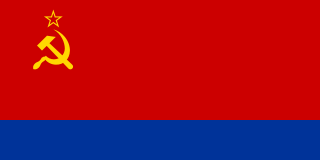
The Azerbaijan Soviet Socialist Republic, also referred to as the Azerbaijani Soviet Socialist Republic, Azerbaijan SSR, Azerbaijani SSR, AzSSR, Soviet Azerbaijan or simply Azerbaijan, was one of the constituent republics of the Soviet Union between 1922 and 1991. Created on 28 April 1920 when the Russian Soviet Federative Socialist Republic brought pro-Soviet figures to power in the region, the first two years of the Azerbaijani SSR were as an independent country until incorporation into the Transcaucasian SFSR, along with the Armenian SSR and the Georgian SSR.

Stepan Georgevich Shaumian was an Armenian Bolshevik revolutionary and politician active throughout the Caucasus. His role as a leader of the Russian Revolution in the Caucasus earned him the nickname of the "Caucasian Lenin", a reference to Russian revolutionary leader Vladimir Lenin.
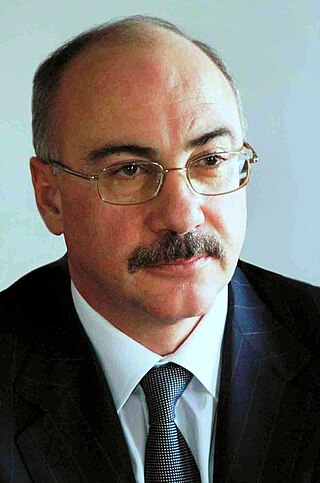
Arkadi Arshaviri Ghukasyan is an Armenian politician who served as the second President of the self-proclaimed Nagorno-Karabakh Republic. He was elected as the President on 8 September 1997 and re-elected in 2002, until his term ended on 7 September 2007 and was succeeded by Bako Sahakyan. He was detained by Azerbaijani forces after the 2023 Azerbaijani offensive in Nagorno-Karabakh and is currently facing criminal charges in Azerbaijan.

The Azerbaijan Democratic Republic, also known as the Azerbaijan People's Republic, was the first secular democratic republic in the Turkic and Muslim worlds. The ADR was founded by the Azerbaijani National Council in Tiflis on 28 May 1918 after the collapse of the Transcaucasian Democratic Federative Republic, and ceased to exist on April 28, 1920. Its established borders were with Russia to the north, the Democratic Republic of Georgia to the north-west, the Republic of Armenia to the west, and Iran to the south. It had a population of around 3 million. Ganja was the temporary capital of the Republic as Baku was under Bolshevik control. The name of "Azerbaijan" which the leading Musavat party adopted, for political reasons, was, prior to the establishment of the Azerbaijan Democratic Republic in 1918, exclusively used to identify the adjacent region of contemporary northwestern Iran.

The National Assembly, also transliterated as Milli Mejlis, is the legislative branch of government in Azerbaijan. The unicameral National Assembly has 125 deputies: previously 100 members were elected for five-year terms in single-seat constituencies and 25 were members elected by proportional representation; as of the latest election, however, all 125 deputies are returned from single-member constituencies.
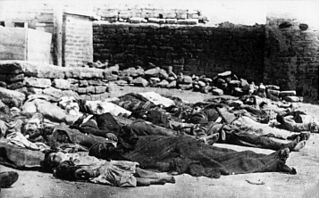
The March Days or March Events was a period of inter-ethnic strife and clashes which took place between 30 March – 2 April 1918 in the city of Baku and adjacent areas of the Baku Governorate of the Transcaucasian Commissariat.
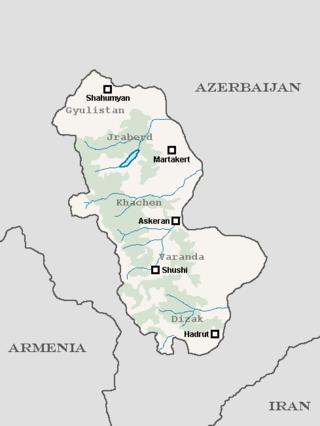
The Karabakh Council was the unrecognised government over Mountainous Karabakh (Nagorno-Karabakh) in eastern Armenia between 1918 and 1920. The council's body was elected by the assembly of Mountainous Karabakh—the representative body of the people of Nagorno-Karabakh—on 27 July 1918. Initially it was called the People's Government of Karabakh, but in September 1918 it was renamed into the Karabakh Council. The Karabakh Council's control throughout 1918–1920 did not exceed the ethnic Armenian locales of Karabakh which were subordinate to them. The council's statehood related to the historical Artsakh province and the modern-day self-proclaimed Republic of Artsakh founded in 1991. Its capital was the city of Shushi (Shusha).

The Armenian-Azerbaijani war (1918–1920) was a conflict that took place in the South Caucasus in regions with a mixed Armenian-Azerbaijani population, broadly encompassing what are now modern-day Azerbaijan and Armenia. It began during the final months of World War I and ended with the establishment of Soviet rule.

Christianity in Azerbaijan is a minority religion. Christians who estimated between 280,000 and 450,000 (3.1%–4.8%) are mostly Russian and Georgian Orthodox. There is also a small Protestant Christian community which mostly came from Muslim backgrounds. Due to the very hostile relations between Azerbaijan and Armenia, Armenian Christians have practically entirely fled the country, and so the Christians in Azerbaijan are members of various other groups, mostly Russians.

The 26 Baku Commissars were Bolshevik and Left Socialist Revolutionary (SR) members of the Baku Commune. The commune was established in the city of Baku, which was then the capital of the briefly independent Azerbaijan Democratic Republic, and is now the capital of the Republic of Azerbaijan. The commune, led by Stepan Shahumyan, existed until 26 July 1918 when the Bolsheviks were forced out of power by a coalition of Dashnaks, Right SRs and Mensheviks.
The Armenian national movement included social, cultural, but primarily political and military movements that reached their height during World War I and the following years, initially seeking improved status for Armenians in the Ottoman and Russian Empires but eventually attempting to achieve an Armenian state.
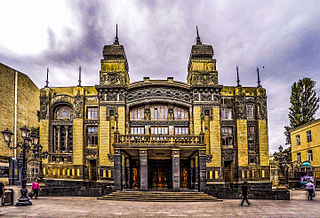
The Azerbaijan State Academic Opera and Ballet Theater is an opera house in Baku, Azerbaijan. Formerly known as the Mailov Theatre, was built in 1911 by Armenian architect Nikolai Bayev.
Armenians in Azerbaijan are the Armenians who lived in great numbers in the modern state of Azerbaijan and its precursor, Soviet Azerbaijan. According to the statistics, about 500,000 Armenians lived in Soviet Azerbaijan prior to the outbreak of the First Nagorno-Karabakh War in 1988. Most of the Armenians in Azerbaijan had to flee the republic, like Azerbaijanis in Armenia, in the events leading up to the First Nagorno-Karabakh War, a result of the ongoing Armenian-Azerbaijani conflict. Atrocities directed against the Armenian population took place in Sumgait, Ganja and Baku. Armenians continued to live in large numbers in the region of Nagorno-Karabakh, which was controlled by the break-away state known as the Nagorno-Karabakh Republic from 1991 until the region was forcibly retaken by Azerbaijan in 2023. After the Azerbaijani takeover, almost all Armenians living in Nagorno-Karabakh left the region.
The Baku pogrom was a pogrom directed against the ethnic Armenian inhabitants of Baku, Azerbaijan SSR. From January 12, 1990, a seven-day pogrom broke out against the Armenian civilian population in Baku during which Armenians were beaten, murdered, and expelled from the city. There were also many raids on apartments, robberies and arsons. According to the Human Rights Watch reporter Robert Kushen, "the action was not entirely spontaneous, as the attackers had lists of Armenians and their addresses". The pogrom of Armenians in Baku was one of the acts of ethnic violence in the context of the First Nagorno-Karabakh War, directed against the demands of the Nagorno-Karabakh Armenians to secede from Azerbaijan and unify with Armenia.

Rail transport in Azerbaijan is operated by the national state-owned railway company Azerbaijan Railways. The railway network consists of 2,918 km (1,813 mi), its gauge is 1,520 mm, 815 km (506 mi) are double track and 1,272 km (790 mi) are electrified at 3 kV (3,000 V) DC.

Azadliq Square, in Baku is the biggest city-centre square in Azerbaijan. It lies next to Baku Boulevard.

Azerbaijan Railways is the national state-owned rail transport operator in the Republic of Azerbaijan. The 2,918 km (1,813 mi), 1,520 mm gauge network is electrified at 3 kV (3,000 V) DC. The headquarters of the Azerbaijan Railways is in the capital Baku.

Foreign relations exist between Azerbaijan and Poland. The embassy of Poland opened in Azerbaijan on August 23, 2001, and the Azerbaijani Embassy in Poland on August 30, 2004. Both countries are full members of the Council of Europe and the Organization for Security and Co-operation in Europe (OSCE).

The Karabakh movement, also known as the Artsakh movement, was a national mass movement in Armenia and Nagorno-Karabakh from 1988 to 1991 that advocated for the transfer of the mainly Armenian-populated Nagorno-Karabakh Autonomous Oblast of neighboring Azerbaijan to the jurisdiction of Armenia.
The following is a timeline of the history of the city of Baku, Azerbaijan.















